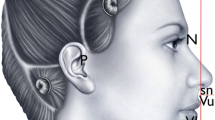Abstract
Background
The goal of mentoplasty is to improve chin projection. Traditionally, this is accomplished by either mandibular osteotomy or alloplastic implants. However, these procedures are not free of complications. This report describes gliding mentoplasty, a novel, simple technique for chin projection.
Methods
The 12 patients in this study underwent gliding mentoplasty. By means of a 2-cm intraoral incision, a subcutaneous dissection was made in the caudal direction. The dissection then proceeded in the subperiosteal plane, leaving a 1-cm cuff of muscle attached to the bone, and advanced toward the lower border of the chin. Subsequently, the dissection was extended laterally, and the whole mental area was dissected from the surrounding tissue. Three 2-0 monofilament nylon sutures were placed in the submandibular periosteum and connected through the remaining muscle cuff to the periosteum. These key sutures allowed the submandibular region to slide forward, project the subcutaneous tissue and mentalis muscle, define the labiomental fold, and improve the pogonion projection.
Results
Gliding mentoplasty resulted in a symmetric projection of the chin in all cases. In two patients, a submandibular dimple developed, which spontaneously resolved in 1 month. No revision surgery was performed, and no tissue relapse was noted. The mean follow-up period was 24.7 ± 5.17 months (range 19–33 months). All the patients were satisfied with the result.
Conclusion
Gliding mentoplasty is a simple, easy-to-perform, rapid surgical technique of chin projection that produces low pain, rapid recovery, and excellent cosmetic results.
Level of Evidence IV
This journal requires that authors assign a level of evidence to each article. For a full description of these Evidence-Based Medicine ratings, please refer to the Table of Contents or the online Instructions to Authors www.springer.com/00266.












Similar content being viewed by others
References
McCarthy JG, Ruff GL (1988) The chin. Clin Plast Surg 15:125–137
González-Ulloa M, Stevens E (1974) The role of chin correction in profiloplasty. Plast Reconstr Surg 41:477–486
Sugawara J, Aymach Z, Nagasaka DH, Kawamura H, Nanda R (2010) “Surgery first” orthognathics to correct a skeletal class II malocclusion with an impinging bite. J Clin Orthod 44:429–438
Santos JF Jr, Abrahão M, Gregório LC, Zonato AI, Gumieiro EH (2007) Genioplasty for genioglossus muscle advancement in patients with obstructive sleep apnea-hypopnea syndrome and mandibular retrognatia. Rev Bras Otorrinolaringol 73:480–486
Warren SM, Spector JA, Zide BM (2007) Chin surgery VII: the textured secured implant: a recipe for success. Plast Reconstr Surg 120:1378–1385
Ilhan AE, Kayabasoglu G, Kazikdas KC, Goksel A (2011) Prolene mesh mentoplasty. Eur Arch Otorhinolaryngol 268:585–589
Vuyk HD (1996) Augmentation mentoplasty with solid silicone. Clin Otolaryngol Allied Sci 21:106–118
Gross EJ, Hamilton MM, Ackermann K, Perkins SW (1999) Mersilene mesh chin augmentation. Arch Facial Plast Surg 1:183–189
Panossian A, Garner W (2004) Polytetrafluoroethylene facial implants: 15 years later. Plast Reconstr Surg 113:347–349
Gürlek A, Firat C, Aydogan H, Celik M, Ersöz-Öztürk A, Kilinç H (2007) Augmentation mentoplasty with diced high-density porous polyethylene. Plast Reconstr Surg 119:684–691
Pitanguy I, Martello L, Caldeira AML, Alexandrino A (1986) Augmentation mentoplasty: a critical analysis. Aesthetic Plast Surg 10:161–169
Friedland JA, Coccaro PJ, Converse JM (1976) Retrospective cephalometric analysis of mandibular bone absorption under silicone rubber chin implants. Plast Reconstr Surg 57:144–151
Cohen SR, Mardach OL, Kawamoto HK Jr (1991) Chin disfigurement following removal of alloplastic chin implants. Plast Reconstr Surg 88:62–70
Matarasso A, Elias AC, Elias RL (1996) Labial incompetence: a marker for progressive bone resorption in silastic chin augmentation. Plast Reconstr Surg 98:1007–1015
Saleh HA, Lohuis PJ, Vuyk HD (2002) Bone resorption after alloplastic augmentation of the mandible. Clin Otolaryngol Allied Sci 27:129–132
Lin JA, Chen X (2012) Modified technique of chin augmentation with MEDPOR for Asian patients. Aesthet Surg J 32:799–803
Godin M, Costa L, Romo T, Truswell W, Wang T, Williams E (2003) Gore-Tex chin implants: a review of 324 cases. Arch Facial Plast Surg 5:224–227
Cingi C, Songu M, Thomas JR (2010) Augmentation mentoplasty with osteocartilaginous nasal graft. Otolaryngol Head Neck Surg 143:549–553
Du BJ, Liu DL, Su B, Liu YS, Zheng JS (2006) Genioplasty with morselized autologous bone graft (Chinese). Nan Fang Yi Ke Da Xue Xue Bao 26:1063–1065
Viterbo F (2003) Chin augmentation with conchal cartilage. Plast Reconstr Surg 111:899–903
Posnick JC, Al-Qattan MM, Stepner NM (1996) Alteration in facial sensibility in adolescents following sagittal split and chin osteotomies of the mandible. Plast Reconstr Surg 97:920–927
Westermark A, Bystedt H, Von Konow L (1998) Inferior alveolar nerve function after mandibular osteotomies. Br J Oral Maxillofac Surg 36:425–428
Teerijoki-Oksa T, Jääskeläinen SK, Soukka T, Virtanen A, Forssell H (2011) Subjective sensory symptoms associated with axonal and demyelinating nerve injuries after mandibular sagittal split osteotomy. Br J Oral Maxillofac Surg 69:208–213
Kobayashi T, Izumi N, Kojima T, Sakagami N, Saito I, Saito C (2012) Progressive condylar resorption after mandibular advancement. Br J Oral Maxillofac Surg 50:176–180
Zide BM, McCarthy J (1989) The mentalis muscle: an essential component of chin and lower lip position. Plast Reconstr Surg 83:413–420
Pape ID, Capone RB (2001) Botulinum toxin A for mentalis muscle dysfunction. Arch Facial Plast Surg 3:268–269
Alatel AI, Al Majid EA (2012) Soft tissue genioplasty: new modality of chin surgery utilizing mentalis muscle only. Saudi Med J 33:1290–1295
Acknowledgments
We thank Dr. Antonio Graziosi and Dr. Janna Joethy for revision of the text.
Author information
Authors and Affiliations
Corresponding author
Rights and permissions
About this article
Cite this article
Viterbo, F., Brock, R.S. Gliding Mentoplasty: A New Technique. Aesth Plast Surg 37, 1120–1127 (2013). https://doi.org/10.1007/s00266-013-0226-x
Received:
Accepted:
Published:
Issue Date:
DOI: https://doi.org/10.1007/s00266-013-0226-x




